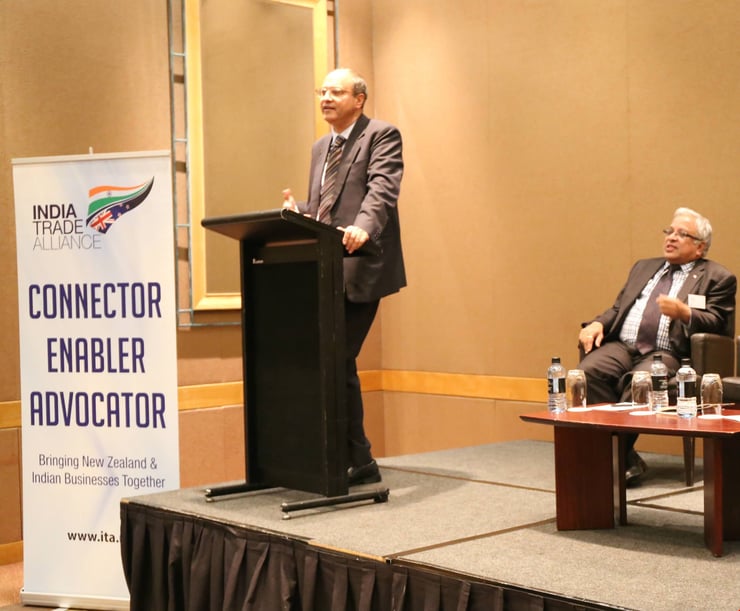India-New Zealand FTA: Is there a way forward?

India and New Zealand have a longstanding, friendly and growing relationship lasting more than a century. As part of a broader objective of deeper economic integration with Asia, New Zealand and India embarked on negotiating a bilateral free trade agreement (FTA) in April 2010. Ten rounds of negotiations have now been completed as of February 2015. Concomitantly, the two countries have also been on the negotiating table as part of members of the Regional Comprehensive Economic Partnership (RCEP) agreement that also includes the 10 members of ASEAN (Brunei-Darussalam, Cambodia, Indonesia, Laos, Malaysia, Myanmar, the Philippines, Singapore, Thailand and Vietnam) plus four other countries with which ASEAN has existing free trade agreements, viz. Australia, China, Japan and Korea. Formal negotiations for the RCEP agreement started in May 2013. Twelve rounds of negotiations have been held so far, with the most recent held in Perth in April 2016.
New Zealand’s gains from entering into an FTA with India, a US $ 2 trillion economy, growing at an average real rate of around eight per cent, are well understood. There is a growing trading relationship, with the value of trade in goods nearly doubling in the last seven years, from NZ $620 million in 2007 to NZ $1.1 billion in 2014. New Zealand merchandise exports to India in 2015 comprised mainly of logs and wood products (about 33%), confidential items (including postal packages and samples, etc., (19%), wool not carded or combed (6%), edible fruits (apples and kiwi fruits) (6%) and iron and steel (6%). In contrast, its imports from India comprised mainly retail medicines (10%), precious metal jewellery (10%), copper and articles (6%), and motor vehicles (about 6%). India was New Zealand’s eighth largest export destination as of September 2015.
There has also been a significant expansion in a two-way bilateral trade in commercial services between the two countries, although detailed sectoral data remains unavailable. Education and tourism have been the prime export earners in the services sector for New Zealand’s trade with India. India is the second largest market for international students in New Zealand, with 15,145 Indian students studying here in 2014, up from 6,348 in 2008. Education travel services is New Zealand’s largest export to India, earning the economy close to half a billion dollars, which is nearly eight folds compared to the levels in 2007. 2014 tourism statistics shows that 33,904 Indians visited New Zealand, contributing an estimated $156 million to the New Zealand economy. There are also opportunities to grow exports to India in other service areas including the skills development, IT, aviation, engineering, and construction sectors. New Zealand has great technological abilities in cold storage supply chain management and post-harvest technologies, which are of interest to India. India and New Zealand have recently signed an air services agreement in a bid to boost connectivity, tourism and trade between both countries.
Against this backdrop, the India Trade Alliance (ITA) had the opportunity to organise an interactive session with Mr Arvind Mehta, India’s lead negotiator for RCEP and FTA negotiations involving New Zealand.
Welcoming the guests, Chairman Giri Gupta said that while FTA seems to be sitting at a stalemate with 10 rounds of negotiations and still counting, he applauded Mr Mehta’s statement on the "best is the enemy of the good". He went on to say that based on ITA’s core values, ITA will continue to strive to make that good better and eventually we will get to the best.
What emerged from the discussion was that a possible India-New Zealand FTA must be broad-based and has to keep in mind the mutual gains for both trading partners. This implies that if the bilateral FTA is focused on tariff reductions on goods only it would result in uneven gains since New Zealand, as an aggressive globaliser, has tariff rates on goods that are already substantially lower than India’s. The margin of tariff preference is, therefore, likely to be much higher for New Zealand exporters leading them to utilise such an agreement, while providing little or no incentives for Indian exporters to do the same.
The Indian perspective put forward by the lead negotiator was that India views New Zealand relations are important and could consider an early harvest FTA involving services and investment before offering tariff concessions to moderate levels in goods. This will offer opportunities for New Zealand to export more goods at lower than existing tariffs, and for Indian service providers and investors to expand their footprint in the New Zealand market. This would be easier to accomplish at the bilateral level rather than as part of the RCEP negotiations, which were more complex and likely to be prolonged.
The discussion brought forth the dilemma that post-TPP, a move to zero tariffs seems to be regarded as a gold standard in future FTAs involving TPP members such as New Zealand, which has a strong revenue loss and political implications in a developing country such as India, and hence would not be feasible. The Indian negotiator was therefore of the view that an agreement that involves a TPP minus framework would work better in terms of taking the negotiations forward. The negotiator was in agreement that non-tariff barriers are also an important part of expanding the bilateral trade relationship and can be dealt with on a case by case basis while negotiating the FTA as they are industry specific.
There were some concerns raised at this session regarding the justification for the existing 30% tariffs on kiwifruit imported by India from New Zealand, and whether it would be dealt with as part of the FTA, which is surprising given that this specific fruit doesn’t face domestic competition in India. The negotiator suggested that a mutual discussion of the New Zealand kiwifruit industry with that of Ministry of Agriculture in India may be required to resolve this.
Emphasising on the importance of having the participation of many countries in a Trade Agreement rather than just two, Mr Mehta encouraged the New Zealand government to look beyond the existing proposition of a bilateral agreement. He also stressed upon the fact that while India had a lot to offer in the services sector, reciprocity would be difficult and an exclusive FTA may end up in endless negotiations.
One of the attendees from a leading Indian services sector firm said, “It was most useful to hear about the impacts on the ‘services’ sector as much as on the ‘manufacturing’ sector, which tends to get more press time. Clearly the opportunities around greater access for service organisations such as ours to bring in skilled resources to help our New Zealand customers is a topic we will be following with great interest.
“Such interactive sessions gives New Zealand businesses an insight into the overall picture on how the Indian government is approaching its foreign policy especially when it comes to dealing with FTAs with countries such as New Zealand. Kiwi businesses need not hold on to FTA before diving into the growing Indian market, he said. While New Zealand wants a comprehensive FTA with India, what is important is that India is still open for business and there is a lot that New Zealand businesses can offer right now, which will certainly help fast-track a comprehensive FTA.”
Overall, the interactive session was fruitful for the attendees, as it provided an insider view of the dilemmas faced by trade negotiators and that the view on both sides of the table needs to be considered for an outcome that is balanced and benefits businesses in both countries.
The event was supported by PwC, Asia New Zealand Foundation, NZ Tech, EMA and ASB.
India and New Zealand have a longstanding, friendly and growing relationship lasting more than a century. As part of a broader objective of deeper economic integration with Asia, New Zealand and India embarked on negotiating a bilateral free trade agreement (FTA) in April 2010. Ten rounds of...
India and New Zealand have a longstanding, friendly and growing relationship lasting more than a century. As part of a broader objective of deeper economic integration with Asia, New Zealand and India embarked on negotiating a bilateral free trade agreement (FTA) in April 2010. Ten rounds of negotiations have now been completed as of February 2015. Concomitantly, the two countries have also been on the negotiating table as part of members of the Regional Comprehensive Economic Partnership (RCEP) agreement that also includes the 10 members of ASEAN (Brunei-Darussalam, Cambodia, Indonesia, Laos, Malaysia, Myanmar, the Philippines, Singapore, Thailand and Vietnam) plus four other countries with which ASEAN has existing free trade agreements, viz. Australia, China, Japan and Korea. Formal negotiations for the RCEP agreement started in May 2013. Twelve rounds of negotiations have been held so far, with the most recent held in Perth in April 2016.
New Zealand’s gains from entering into an FTA with India, a US $ 2 trillion economy, growing at an average real rate of around eight per cent, are well understood. There is a growing trading relationship, with the value of trade in goods nearly doubling in the last seven years, from NZ $620 million in 2007 to NZ $1.1 billion in 2014. New Zealand merchandise exports to India in 2015 comprised mainly of logs and wood products (about 33%), confidential items (including postal packages and samples, etc., (19%), wool not carded or combed (6%), edible fruits (apples and kiwi fruits) (6%) and iron and steel (6%). In contrast, its imports from India comprised mainly retail medicines (10%), precious metal jewellery (10%), copper and articles (6%), and motor vehicles (about 6%). India was New Zealand’s eighth largest export destination as of September 2015.
There has also been a significant expansion in a two-way bilateral trade in commercial services between the two countries, although detailed sectoral data remains unavailable. Education and tourism have been the prime export earners in the services sector for New Zealand’s trade with India. India is the second largest market for international students in New Zealand, with 15,145 Indian students studying here in 2014, up from 6,348 in 2008. Education travel services is New Zealand’s largest export to India, earning the economy close to half a billion dollars, which is nearly eight folds compared to the levels in 2007. 2014 tourism statistics shows that 33,904 Indians visited New Zealand, contributing an estimated $156 million to the New Zealand economy. There are also opportunities to grow exports to India in other service areas including the skills development, IT, aviation, engineering, and construction sectors. New Zealand has great technological abilities in cold storage supply chain management and post-harvest technologies, which are of interest to India. India and New Zealand have recently signed an air services agreement in a bid to boost connectivity, tourism and trade between both countries.
Against this backdrop, the India Trade Alliance (ITA) had the opportunity to organise an interactive session with Mr Arvind Mehta, India’s lead negotiator for RCEP and FTA negotiations involving New Zealand.
Welcoming the guests, Chairman Giri Gupta said that while FTA seems to be sitting at a stalemate with 10 rounds of negotiations and still counting, he applauded Mr Mehta’s statement on the "best is the enemy of the good". He went on to say that based on ITA’s core values, ITA will continue to strive to make that good better and eventually we will get to the best.
What emerged from the discussion was that a possible India-New Zealand FTA must be broad-based and has to keep in mind the mutual gains for both trading partners. This implies that if the bilateral FTA is focused on tariff reductions on goods only it would result in uneven gains since New Zealand, as an aggressive globaliser, has tariff rates on goods that are already substantially lower than India’s. The margin of tariff preference is, therefore, likely to be much higher for New Zealand exporters leading them to utilise such an agreement, while providing little or no incentives for Indian exporters to do the same.
The Indian perspective put forward by the lead negotiator was that India views New Zealand relations are important and could consider an early harvest FTA involving services and investment before offering tariff concessions to moderate levels in goods. This will offer opportunities for New Zealand to export more goods at lower than existing tariffs, and for Indian service providers and investors to expand their footprint in the New Zealand market. This would be easier to accomplish at the bilateral level rather than as part of the RCEP negotiations, which were more complex and likely to be prolonged.
The discussion brought forth the dilemma that post-TPP, a move to zero tariffs seems to be regarded as a gold standard in future FTAs involving TPP members such as New Zealand, which has a strong revenue loss and political implications in a developing country such as India, and hence would not be feasible. The Indian negotiator was therefore of the view that an agreement that involves a TPP minus framework would work better in terms of taking the negotiations forward. The negotiator was in agreement that non-tariff barriers are also an important part of expanding the bilateral trade relationship and can be dealt with on a case by case basis while negotiating the FTA as they are industry specific.
There were some concerns raised at this session regarding the justification for the existing 30% tariffs on kiwifruit imported by India from New Zealand, and whether it would be dealt with as part of the FTA, which is surprising given that this specific fruit doesn’t face domestic competition in India. The negotiator suggested that a mutual discussion of the New Zealand kiwifruit industry with that of Ministry of Agriculture in India may be required to resolve this.
Emphasising on the importance of having the participation of many countries in a Trade Agreement rather than just two, Mr Mehta encouraged the New Zealand government to look beyond the existing proposition of a bilateral agreement. He also stressed upon the fact that while India had a lot to offer in the services sector, reciprocity would be difficult and an exclusive FTA may end up in endless negotiations.
One of the attendees from a leading Indian services sector firm said, “It was most useful to hear about the impacts on the ‘services’ sector as much as on the ‘manufacturing’ sector, which tends to get more press time. Clearly the opportunities around greater access for service organisations such as ours to bring in skilled resources to help our New Zealand customers is a topic we will be following with great interest.
“Such interactive sessions gives New Zealand businesses an insight into the overall picture on how the Indian government is approaching its foreign policy especially when it comes to dealing with FTAs with countries such as New Zealand. Kiwi businesses need not hold on to FTA before diving into the growing Indian market, he said. While New Zealand wants a comprehensive FTA with India, what is important is that India is still open for business and there is a lot that New Zealand businesses can offer right now, which will certainly help fast-track a comprehensive FTA.”
Overall, the interactive session was fruitful for the attendees, as it provided an insider view of the dilemmas faced by trade negotiators and that the view on both sides of the table needs to be considered for an outcome that is balanced and benefits businesses in both countries.
The event was supported by PwC, Asia New Zealand Foundation, NZ Tech, EMA and ASB.







Leave a Comment